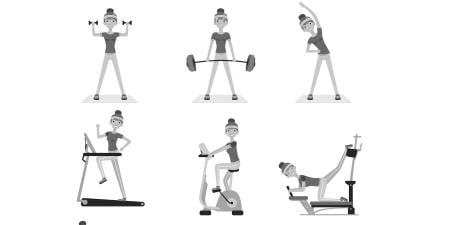Case
Mrs. Cassidy Kellogg appeared to be in good physical condition, sitting on the exam table, engrossed in marking a series of papers with a red pencil. Internist Dana Haselton had seen Mrs. Kellogg twice before, each time for a well-woman check-up. Dr. Haselton glanced at the patient record and saw that it was not yet time for Mrs. Kellogg's third annual check-up. Looking over the record quickly, she saw that her patient was 36 years old, married, and a university professor and that she was in the office today to "check on her heart." Mrs. Kellogg's height, weight and blood pressure, as recorded by the nurse minutes before, were 68 in, 133 lbs, and 90 over 60, respectively.
"How have you been since your last visit?" Dr. Haselton asked.
"I'm fine. I just want you to check out my heart. The other night I woke up in the middle of the night, and when I stood up to go into the bathroom, I got really dizzy." I want to make sure my heart's okay, because I work out pretty regularly."
"That could be from several things," Dr. Haselton said. Your blood pressure is low—which is good—but that could contribute to the dizziness you report. How often do you work out?"
"Every day. A couple of hours every day."
"Tell me about your exercise program."
Mrs. Kellogg reported that she went to one gym—a women's gym, with machines—in the morning before school and then did some "more serious work" after school: machines, free weights, calisthenics. If she felt like it, she would run 2 or 3 nights a week and do longer runs on weekends.
"That's quite an exercise program," said Dr. Haselton. Referring to the chart to check on her patient's marital status, Dr. Haselton asked, "Does your husband work out with you?"
"No. They have a fit—John and the kids. I'm at the gym early in the morning and then at the other gym or running when they have dinner, not that I'd eat what they eat anyway."
Upon further questioning, it turned out that John Kellogg made dinner for himself and the kids. But Mrs. Kellogg stuck to her protein shakes, yogurt, and grains, occasionally eating a bite of salad or fish with the family.
"If I ate like they do, I'd be big as a house," said Dr. Haselton's tall patient with well-defined muscles and no body fat that one could pinch between the fingers.
"What's the highest your weight has ever been?" asked Dr. Haselton.
"I weighed almost 151 when I was pregnant," came the reply. "Both pregnancies. It was disgusting. But we're way off track, here." Mrs. Kellogg sounded impatient. I just want an EKG to see whether my heart's all right. If I can't work out, I'll die. When can you schedule the EKG?
Commentary 2
Dr. Kellogg's complaint of lightheadness appears to be the tip of the iceberg. From her history it is clear that she has restrictive eating patterns and likely uses excessive exercise as a way to control her weight. She may realize this at some level or she may actually think that she is practicing a "healthy lifestyle." Her comments regarding her weight gain during her pregnancies are alarming, since her weight gain was minimal. Her multiple daily workouts and eating practices at the expense of her family time are also "red flags." Her history suggests that these behaviors may be habitual at this point. These behaviors may be hard to change, particularly if the patient is not ready or willing to accept that her "healthy lifestyle" may actually be harming her and her family.
The Female Athlete Triad
Is she actually harming herself with these behaviors or is she just ultrahealthy? It is hard to say without more history, but based on the information we have, we can surmise that she has disordered eating at a minimum and possibly a full-blown eating disorder. Disordered eating (including true eating disorders) is one of the 3 components of the female athlete triad. The triad consists of 3 interrelated but distinct conditions: disordered eating, amenorrhea/oligomenorrhea, and osteopenia.1 A female with a chronically negative energy balance (more calories out than in) can suffer from disruption of the normal reproductive hormonal axis. Suppression of this axis can lead to oligomenorrhea or amenorrhea. Loss of regular menstrual cycles can lead to poor bone formation and increased bone loss. This can increase one's risk of developing stress fractures and osteoporosis.
Evaluating a patient for the triad requires a comprehensive history including her exercise history, diet history, menstrual history, injury history, psychiatric history, and family history in addition to a complete physical examination and appropriate laboratory testing.
Time Management
Trying to do a comprehensive evaluation for the Triad in this patient at this visit is probably not practical and will likely be frustrating for the patient and overwhelming for Dr. Hazelton. For this visit, Dr. Hazleton should use Mrs. Kellogg's concern about her heart as a springboard into future discussions regarding her overall health and lifestyle.
- Start by focusing on standard questions for a cardiac evaluation (ie, chest pain, shortness of breath, syncope, family history of sudden death, recent viral illness, etc) Consider her request for an EKG, and be prepared to provide an explanation if an EKG is medically indicated.
- Orthostatic blood pressure and pulse measurements may reproduce her symptoms or provide objective data of inadequate hydration.
- Discussing fluid intake with an active patient is a good way to open the door to further discussions about nutrition.
- A brief menstrual history discussion can be initiated by asking the patient if she may be pregnant and explaining to her that many pregnant women get lightheaded with quick changes in position. If the patient reports infrequent or no menstrual cycles, this would open the door to further evaluation including lab work and follow-up appointments where these areas can be discussed in more detail.
- Request a future visit to spend more time on nutrition, exercise habits, etc.
Patient Participation
For this evaluation to continue, the patient will have to "buy into" her physician's concerns and recommendations at some level. Some patients with disordered eating may be secretive and ashamed of their true eating behaviors. Others believe that they have the "perfect diet" and won't understand that their good intentions may not be healthy. A simple explanation of possible health risks may be all that is needed for some patients to understand the physician's concern. Other patients will resist intervention. Dr. Hazelton should persist in expressing her concern, just as she would with a patient who continues to smoke, and, one hopes, it may eventually have an impact.
References
- American College of Sports Medicine. Position stand. The female athlete triad. Med Sci Sports Exerc. 1997;29(5):i-ix.



